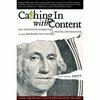The concept of content does not typically get a lot of coverage outside of those who create and sell it. That’s why it’s interesting that there are two new, compelling books, covering the world of content.
Having spent the day in the jury pool at the US Federal Court's Southern District, I've gotten a great opportunity to catch up on my reading.
John Battelle’s analysis of Google, The Search, has cracked the top 100 list at Amazon and has been selected as one of five nominees for the FT/Goldman Sachs "Business Book of the Year." I will post a review of The Search shortly, particularly if I find myself selected for this jury.
At the same time, another new book has emerged, sharing case studies on companies who have successfully leveraged content on the Web. David Meerman Scott’s Cashing in with Content is not a content industry book, per se. Instead, it’s geared towards marketing professionals, business leaders, and anyone looking to communicate a message effectively, whether for marketing, awareness, recruitment or other purposes.
 The heart of the book is a series of twenty case studies of organizations which utilize content effectively. They are broken into three groups: E-Commerce, Business-to-business, and Educational, Healthcare, Nonprofit and Politics. The case studies are well set-up and include interviews with key executives at each organization. Do yourself a favor and read through all twenty, not just the ones "in your target area". For example, I found that the practices of Aerosmith, Kenyon College and Tourism Toronto were all somewhat relevant to my e-commerce sites' needs.
The heart of the book is a series of twenty case studies of organizations which utilize content effectively. They are broken into three groups: E-Commerce, Business-to-business, and Educational, Healthcare, Nonprofit and Politics. The case studies are well set-up and include interviews with key executives at each organization. Do yourself a favor and read through all twenty, not just the ones "in your target area". For example, I found that the practices of Aerosmith, Kenyon College and Tourism Toronto were all somewhat relevant to my e-commerce sites' needs.
The book concludes by defining a set of twelve best practices, exemplified by the twenty organizations profiled in the case studies. Some of these practices may seem painfully obvious (“If you serve a global market, use global content”) but are often ignored by those developing websites. Others take traditional offline practices and reinforce the need to apply them in the online world, such as “Link Content Directly to the Sales Cycle”. Each of these best practices are then tied back to the specific case studies which support them. For example, in supporting the sales cycle, the Tourism Toronto website supports those travelers first thinking about visiting Canada, then helps them throughout their trip planning. The site also lets users self-select a path, depending upon whether they are an individual planning a vacation or business trip, a tour group or an organization planning a conference or meeting.
Business books are often either too ethereal or focused on practices only the largest organizations can afford. David Scott’s Cashing in with Content is neither. It offers a series of straightforward practices, supported by numerous real-world examples, in an enjoyable, quick read format. If you want to be sure that your organization’s message is being communicated effectively, buy a copy, read it and put it into practice.
Also, be sure to check out David Scott’s Web Ink Now blog, where he continues his focus on how to leverage content to generate results.




Posted by: |